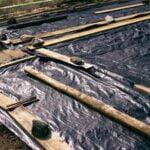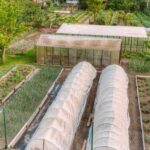Many gardeners often wonder, “Can you use treated lumber for vegetable gardens?” Treated lumber has been a popular choice for building raised beds and other structures in vegetable gardens, but there are some potential concerns to consider. In this article, we will delve into the topic of using treated lumber in vegetable gardens and explore the various aspects of its use.
Before delving into the potential risks and concerns associated with using treated lumber in vegetable gardens, it is essential to understand what treated lumber is and how it is treated for outdoor use. We will take a closer look at the treatment process and the different types of treated lumber available on the market.
While treated lumber can be a convenient option for constructing raised beds and other garden structures, there are potential risks and concerns associated with its use in vegetable gardens. We will discuss these concerns in detail, including the impact on human health and environmental considerations. Additionally, we will explore alternative options for building raised beds or structures for vegetable gardens that may alleviate these concerns.
As we navigate through this topic, we will also provide tips for using treated lumber in vegetable gardens safely and best practices for choosing the right type of treated lumber. Making an informed decision about using treated lumber for your vegetable garden is crucial, and by exploring all aspects of its use, you can make the best choice for your gardening endeavors.
What Is Treated Lumber and How Is It Treated for Outdoor Use?
Treated lumber, also known as pressure-treated wood, is a type of wood that has been treated with chemicals to improve its durability and resistance to degradation in outdoor environments. The treatment process involves placing the wood in a pressurized tank and forcing chemical preservatives into the wood fibers. This helps protect the wood from decay, insect damage, and moisture absorption, making it suitable for use in outdoor structures and vegetable gardens.
Treatment Process
During the treatment process, the wood is placed in a sealed cylinder, and a vacuum is created to remove air from the pores of the wood. Then, the cylinder is flooded with preservative solutions under pressure. Common chemicals used in treated lumber include copper azole, alkaline copper quaternary (ACQ), and creosote. These chemicals penetrate deep into the wood fibers, providing long-lasting protection from decay and insects.
Types of Treated Lumber
There are different levels of treated lumber available depending on where it will be used. Above-ground treated lumber is suitable for applications like decking and fencing, while ground-contact treated lumber is designed for use in direct contact with the ground. It’s important to select the appropriate type of treated lumber based on its intended use to ensure maximum durability and performance.
Benefits of Treated Lumber
The use of treated lumber offers several benefits for outdoor projects like building raised beds for vegetable gardens. Treated lumber can withstand exposure to moisture and soil without rotting or decaying quickly. This makes it an attractive option for gardeners looking for a long-lasting solution for their vegetable garden structures.
Understanding how treated lumber is made and why it’s suitable for outdoor use can help gardeners make informed decisions about whether to use it in their vegetable gardens. However, it’s equally essential to be aware of potential risks associated with using treated lumber in this context as well as alternative options available.
The Potential Risks and Concerns Associated With Using Treated Lumber in Vegetable Gardens
Chemical Leaching
One of the primary concerns associated with using treated lumber in vegetable gardens is the potential for chemicals to leach into the soil. The high-pressure treatment process involves the use of chemicals such as chromated copper arsenate (CCA), which has been known to release arsenic, chromium, and copper into the surrounding environment.
When these chemicals leach into the soil, there is a risk that they may be taken up by the plants and ultimately end up in the fruits and vegetables that are consumed.
Health Risks
The presence of these chemicals in treated lumber raises concerns about potential health risks for those who consume fruits and vegetables grown in a garden constructed with treated lumber. Arsenic, chromium, and copper are all known to have negative health effects when ingested in high quantities, leading to concerns about the safety of consuming produce grown in close proximity to treated lumber.
Regulatory Considerations
In response to these potential risks, there have been regulatory measures put in place to limit or ban certain types of treated lumber for use in applications where human exposure is likely, especially food production areas like vegetable gardens. While restrictions vary by region, it’s important for gardeners to be aware of any local regulations pertaining to the use of treated lumber in vegetable gardens.
Additionally, it’s important to consider alternative options for building raised beds or garden structures that eliminate the need for treated lumber altogether.
Alternative Options for Building Raised Beds or Structures for Vegetable Gardens
When it comes to building raised beds or structures for your vegetable garden, there are alternative options to using treated lumber. One popular alternative is using naturally rot-resistant woods such as cedar, redwood, or black locust.
These types of wood have natural oils and compounds that make them resistant to decay and insect infestations, making them ideal for use in vegetable gardens. While these options may be more expensive than treated lumber initially, they are often considered a safer and more eco-friendly choice in the long run.
Another alternative to treated lumber is using composite materials made from a combination of wood fibers and recycled plastics. These materials are durable, long-lasting, and resistant to moisture and insects.
They also come in a variety of colors and styles, allowing you to customize the look of your raised beds or garden structures. While composite materials may be more expensive than traditional lumber, they require minimal maintenance and have a longer lifespan, making them a cost-effective option over time.
For those looking for a completely chemical-free option, consider using untreated natural stone or brick for building raised beds. Stone or brick can create a beautiful and long-lasting structure for your vegetable garden while providing excellent drainage and insulation for plant roots. While this option may require some skill in construction and may be more labor-intensive initially, the durability and aesthetic appeal of stone or brick make it an attractive choice for many gardeners.
| Alternative Material | Advantages |
|---|---|
| Cedar, Redwood, Black Locust | Naturally rot-resistant; safer choice; eco-friendly |
| Composite Materials | Durable; long-lasting; resistant to moisture and insects |
| Natural Stone or Brick | Durable; excellent drainage; aesthetically appealing |
Tips for Using Treated Lumber in Vegetable Gardens Safely
Treated lumber can be a convenient and durable option for building raised beds and structures for vegetable gardens. However, it is important to take certain precautions to ensure the safety of using treated lumber in your garden. One of the most critical tips for using treated lumber in vegetable gardens is to be aware of the type of treatment used and to understand its potential risks.
When using treated lumber in vegetable gardens, it is advisable to choose products that are labeled as safe for use in areas where food will be grown. Look for lumber that has been treated with non-toxic substances such as copper-based compounds or ACQ (alkaline copper quaternary). These treatments are considered safer options for vegetable gardens compared to older methods involving arsenic or creosote.
Another essential tip for using treated lumber in vegetable gardens safely is to line the interior walls of raised beds with a barrier such as heavy plastic sheeting. This will help prevent direct contact between the soil and the treated wood, reducing the risk of any chemicals leaching into the soil and potentially being taken up by plants. Additionally, consider sealing the cut ends of treated lumber with an appropriate sealant to further minimize any potential leaching of chemicals.
Lastly, it’s important to practice good hygiene when working with treated lumber in vegetable gardens. Wear gloves and long sleeves when handling the wood, especially during installation or construction. After touching treated wood, wash your hands thoroughly before eating or drinking to avoid any accidental ingestion of chemicals.
| Tip | Description |
|---|---|
| Choose safe treatments | Look for non-toxic substances like copper-based compounds or ACQ. |
| Use a barrier | Line raised bed interiors with heavy plastic sheeting. |
| Practice good hygiene | Wear gloves and wash hands thoroughly after handling. |
Environmental Impact of Using Treated Lumber in Vegetable Gardens
Using treated lumber in vegetable gardens can have both positive and negative environmental impacts. It is important to consider the long-term effects of using this type of material in your garden and how it may affect the surrounding environment.
Here are some environmental impacts to consider:
- Positive Impact: Treated lumber can be durable and long-lasting, reducing the need for frequent replacements and therefore reducing overall resource consumption.
- Negative Impact: The chemicals used to treat lumber, such as chromated copper arsenate (CCA), can leach into the soil over time, potentially contaminating nearby water sources and harming plants and beneficial insects.
- Impact on Wildlife: The leaching of chemicals from treated lumber can also impact local wildlife, including birds, small mammals, and aquatic organisms, if they come into contact with contaminated soil or water.
In order to minimize the negative environmental impact of using treated lumber in vegetable gardens, consider the following best practices:
- Use a barrier: Line the interior of raised beds or structures made with treated lumber with a heavy-duty plastic sheet or landscape fabric to prevent direct contact between soil and the treated wood.
- Choose alternative materials: Consider using untreated cedar or redwood for raised beds, as these woods are naturally resistant to decay and insect damage.
- Proper disposal: If treated lumber needs to be replaced, dispose of it properly at a designated facility that handles hazardous materials rather than burning it or throwing it in a landfill where harmful chemicals can leach into the environment.
By being mindful of the potential environmental impact and taking steps to mitigate any negative effects, you can make an informed decision about whether to use treated lumber in your vegetable garden.
Best Practices for Choosing and Using Treated Lumber for Vegetable Gardens
When it comes to using treated lumber for vegetable gardens, there are some best practices to keep in mind to ensure the safety of your plants and the environment. Here are some tips for choosing and using treated lumber responsibly:
- Consider the type of treatment: Treated lumber can be treated with various chemicals such as alkaline copper quaternary (ACQ), copper azole, or creosote. It is important to understand the type of treatment used and choose one that is approved for use in vegetable gardens.
- Check for certification: Look for lumber that has been certified as safe for use in vegetable gardens by organizations such as the Environmental Protection Agency (EPA) or the Forest Stewardship Council (FSC).
- Avoid direct contact with soil: To minimize the risk of leaching chemicals into the soil, consider lining the inside of raised beds or structures with a barrier such as heavy-duty plastic sheeting.
In addition to these best practices, it is important to follow guidelines provided by experts in gardening and environmental conservation. By taking these precautions, gardeners can make informed decisions about using treated lumber in their vegetable gardens while minimizing potential risks.
Conclusion
In conclusion, the decision to use treated lumber for vegetable gardens ultimately comes down to weighing the potential risks against the benefits. While treated lumber can offer durability and stability for raised beds and garden structures, it also presents concerns about chemical leaching into the soil and potential harm to plants and humans.
It is important for gardeners to be informed about the types of treatments used, such as chromated copper arsenate (CCA) or alkaline copper quaternary (ACQ), and their potential impact on the garden ecosystem.
As an alternative to treated lumber, there are numerous options available for building raised beds or structures for vegetable gardens. Untreated cedar or redwood, composite lumber made from recycled materials, or natural stone are all viable options that offer durability and safety without the risk of chemical contamination. Additionally, using non-toxic wood sealants or liners can help mitigate any potential risks associated with using treated lumber in vegetable gardens.
When deciding whether to use treated lumber in a vegetable garden, it is crucial to consider the environmental impact as well. The production and disposal of treated lumber can contribute to various environmental issues, including deforestation, greenhouse gas emissions, and soil contamination. By carefully considering these factors and exploring alternative options, gardeners can make informed decisions that prioritize both the health of their plants and the environment.
Frequently Asked Questions
Is Treated Lumber Safe for Vegetable Gardens?
Treated lumber contains chemicals that can potentially leach into the soil, which may be a concern for vegetable gardens. Some studies have shown that the chemicals in treated lumber can transfer to plants and then to humans when consumed. It’s important to consider these potential risks when deciding whether or not to use treated lumber in a vegetable garden.
Is Home Depot Pressure Treated Wood Safe for Vegetable Gardens?
Home Depot pressure-treated wood is treated with chemicals, such as chromated copper arsenate (CCA) or alkaline copper quaternary (ACQ), to protect it from rot and decay.
While it may be effective for construction purposes, there is some debate about its safety for use in vegetable gardens due to the risk of chemical leaching into the soil and potentially contaminating edible plants.
Is It Safe to Use Treated Lumber for Tomato Stakes?
Using treated lumber for tomato stakes raises similar concerns about chemical leaching as using it for raised beds or other garden structures. The use of treated lumber for tomato stakes may expose plants to chemicals, which could be absorbed by the plants and transferred through consumption.
It’s important to carefully consider whether the benefits of using treated lumber outweigh the potential risks when it comes to growing tomatoes in a home garden setting.

If you’re looking to get into vegetable gardening, or are just looking for some tips on how to make your current garden better, then you’ve come to the right place! My name is Ethel and I have been gardening for years. In this blog, I’m going to share with you some of my best tips on how to create a successful vegetable garden.





